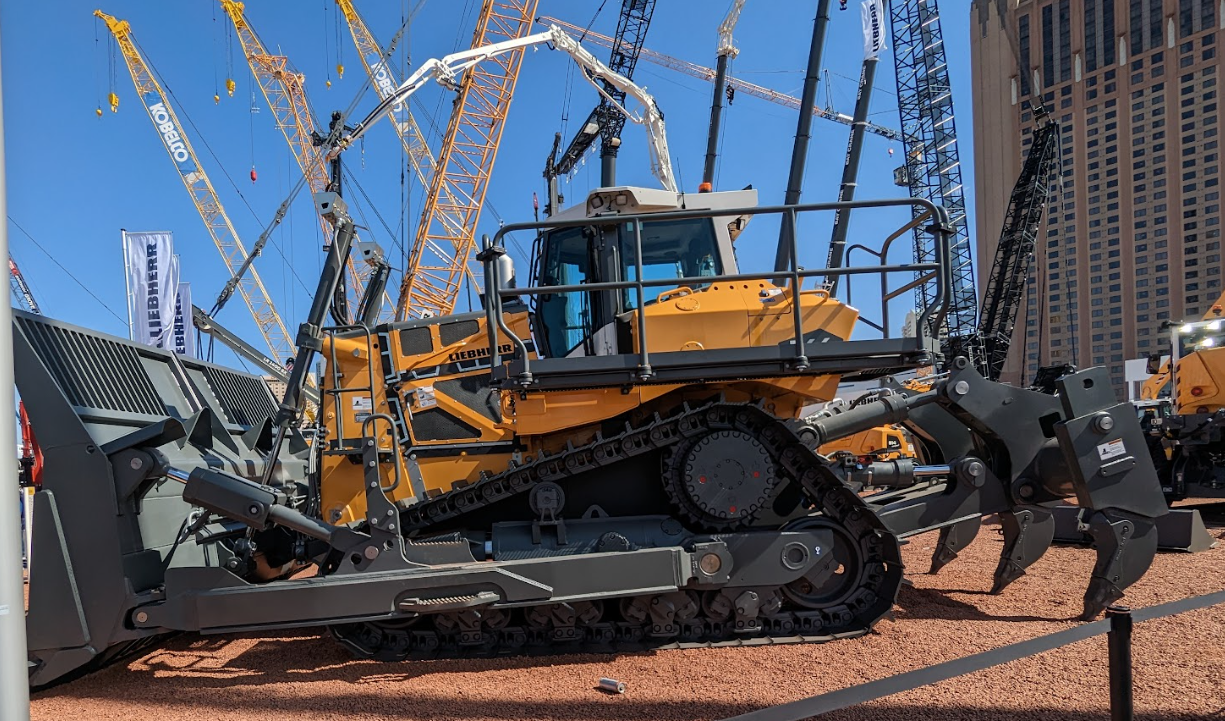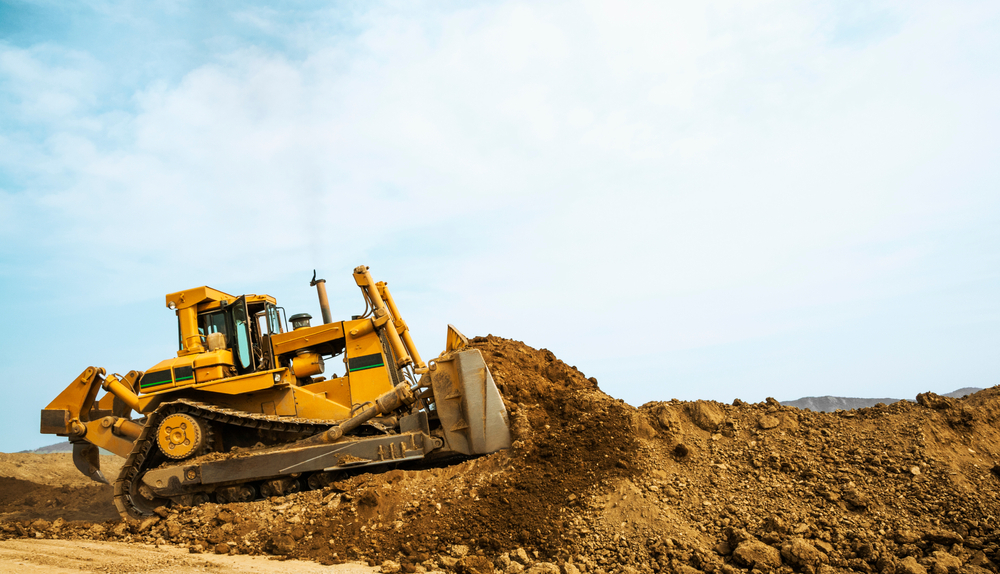Discover The World’s Largest Bulldozer
9 Min read
)
May 7, 2024
A bulldozer is a heavy-duty machine equipped with a large, flat blade at the front, used primarily for pushing large quantities of soil, sand, rubble, or other such material during construction, road building, and other earthmoving tasks. The blade is mounted on the front of the tractor, which provides the power and mobility for the machine. Bulldozers are essential for their ability to handle tough terrain and efficiently move or clear large volumes of material in construction and mining projects.
Here are some detailed specifications and features for the World’s Top 10 Largest of the bulldozers:
1. Komatsu D575A (Japan)
The Komatsu D575A, originating from Japan, weighs approximately 153 tons and boasts a horsepower of 1,150 HP. With a blade capacity of up to 90 cubic yards, it's primarily deployed in large-scale mining and earthmoving projects. Its impressive weight and power make it a formidable force in tackling massive quantities of material with efficiency and precision, contributing to the swift completion of expansive construction undertakings.
2. CAT D11(United States)
:format(webp))
The CAT D11, hailing from the United States, weighs around 230,000 pounds and features a horsepower ranging from 850 to 935 HP. Its blade capacity of 57 cubic yards makes it indispensable in major mining and quarry operations, where it can efficiently move and shape large volumes of earth and rock. Renowned for its robust construction and high performance, the CAT D11 is a trusted workhorse in the mining industry, known for its reliability and durability in challenging environments.
3. Komatsu D475A (Japan)
Also from Japan, the Komatsu D475A weighs approximately 108,390 pounds and delivers 900 HP. Its blade capacity of 35.5 cubic yards makes it ideal for heavy-duty mining and construction tasks, where precision and power are paramount. Designed to excel in demanding conditions, the Komatsu D475A is engineered to deliver exceptional productivity and performance, ensuring optimal results in challenging terrain and adverse weather conditions.
4. CAT D10 (United States)
The CAT D10, a product of the United States, weighs about 146,500 pounds and offers 600 HP. With a blade capacity of approximately 35 cubic yards, it's commonly used in quarry and heavy construction projects, where it can efficiently move and shape large quantities of material. Recognized for its versatility and reliability, the CAT D10 is a versatile machine capable of tackling a wide range of earthmoving tasks with precision and efficiency, making it a valuable asset on construction sites worldwide.
5. Liebherr PR776 (Germany)
:format(webp))
The Liebherr PR776, manufactured in Germany, weighs around 161,354 pounds and can generate up to 768 HP. Its blade capacity of 28 cubic yards makes it well-suited for mining and large earthmoving operations, where it excels in handling heavy-duty tasks with ease and efficiency. Renowned for its robust construction and cutting-edge technology, the Liebherr PR776 delivers exceptional performance and reliability, making it a preferred choice for demanding applications in the construction and mining industries.
6. CAT D9 (United States)
The CAT D9, originating from the United States, weighs approximately 110,000 pounds and boasts a horsepower of 436 HP. With a blade capacity of up to 22 cubic yards, it finds widespread use in general construction and mining operations, where its versatility and maneuverability shine. Renowned for its durability and ruggedness, the CAT D9 is a dependable workhorse capable of tackling a variety of tasks with precision and efficiency, making it a staple on job sites around the world.
7. John Deere 1050K (United States)
From the United States, the John Deere 1050K weighs approximately 95,000 pounds and offers a horsepower of 350 HP. Its blade capacity of 13.5 cubic yards makes it well-suited for construction and heavy clearing tasks, where it excels in moving and shaping large volumes of material. Known for its reliability and performance, the John Deere 1050K is a trusted machine in the construction industry, prized for its durability and versatility in challenging work environments.
8. CAT D8 (United States)
The CAT D8, manufactured in the United States, weighs about 87,000 pounds and delivers 310 HP. With a blade capacity of around 13 cubic yards, it finds application in medium to large construction and mining operations, where it can efficiently move and grade soil and aggregate. Renowned for its rugged construction and high performance, the CAT D8 is a versatile machine capable of handling a wide range of earthmoving tasks with precision and efficiency, making it a valuable asset on construction sites worldwide.
9. Shantui SD90 (China)
The Shantui SD90, originating from China, boasts an estimated weight similar to mid-range CAT models and offers around 500 HP. While its blade capacity is not specifically detailed, it is estimated to be similar to mid-range CAT models. Primarily used in construction, especially in regions where Shantui is a preferred brand, the SD90 is known for its reliability and cost-effectiveness, offering competitive performance in demanding work environments.
10. Fiat Allis FD50 (Italy)
From Italy, the Fiat Allis FD50 weighs around 70,000 pounds and delivers approximately 600 HP. While its blade capacity is not specifically detailed, it finds application in smaller mining operations and large construction sites, where its versatility and maneuverability are prized. Renowned for its reliability and performance, the Fiat Allis FD50 is a trusted machine in the construction and mining industries, valued for its efficiency and durability in demanding work environments.
Here are things you should consider in choosing the proper bulldozer for you to use:
Project Size and Scope:
Large Projects:
For large-scale construction sites, mining operations, or major land clearing, a larger bulldozer with a higher horsepower and larger blade capacity is necessary. These machines can move more material faster and handle tougher terrain.
Smaller Projects:
For smaller projects, such as residential landscaping or small construction tasks, a smaller bulldozer suffices. These are easier to maneuver in tight spaces and are more cost-effective in terms of fuel consumption and operational costs.
Material Type:
Heavy Materials:
When dealing with heavy materials like rock or wet soil, opt for a bulldozer with higher horsepower and a robust build to handle the added weight and resistance effectively.
Lighter Materials:
Conversely, for lighter materials such as dry soil or sand, a bulldozer with less power can still achieve efficient movement without unnecessary strain on the engine.
Terrain:
Rough Terrain:
In rough, uneven, or steep terrains, choose bulldozers with a strong undercarriage design, high torque, and possibly wider tracks to ensure stability and traction on challenging surfaces.
Flat Terrain:
On flatter terrains, standard bulldozers can operate efficiently without requiring specialized adaptations or additional features.
Mobility Needs:
Consider the transportation logistics of the bulldozer, especially for larger models that may require special transport arrangements due to their weight and size. These considerations can impact project costs and scheduling.
Environmental Considerations:
In environmentally sensitive areas, opt for smaller, lighter bulldozers to minimize soil compaction and reduce the machine's overall environmental impact. This choice helps preserve the surrounding habitat and ecosystem integrity.
Operator Comfort and Safety:
Prioritize features that enhance operator comfort and safety, such as good visibility, ergonomic seating, and intuitive controls. A comfortable operating environment promotes operator productivity and reduces the risk of accidents or injuries.
Budget:
Evaluate the total cost of ownership, including initial purchase price, fuel consumption, maintenance expenses, and potential downtime. While larger bulldozers offer greater power and capability, they also come with higher operating and maintenance costs.
Future Needs:
Anticipate future projects or changes in job requirements when selecting a bulldozer. Investing in a slightly larger model with greater versatility can offer long-term benefits and adaptability as project demands evolve over time.
Choosing the right compaction equipment for a project involves evaluating a lot of things, here are some factors you could use:
Soil Type:
Soil composition greatly influences compactor selection. Cohesive soils, like clay, require sheepsfoot rollers because their "feet" penetrate and knead the soil effectively. Granular soils, such as sand or gravel, compact better with smooth wheel rollers, which provide even pressure without sticking to the soil.
Compaction Depth:
The depth of compaction required dictates the choice of equipment. Deeper layers demand heavier machinery with greater compaction force to reach and compress the soil effectively, ensuring stable foundations for structures or pavements.
Project Size and Accessibility:
The scale of the project and site accessibility impact equipment selection. Larger projects with expansive, open areas benefit from larger rollers for efficient compaction. Conversely, smaller or confined spaces necessitate compactors with better maneuverability to access tight spaces.
Material to Be Compacted:
Whether compacting soil or asphalt determines the type of compactor needed. Soil compactors are designed with features like padfoot or smooth drum rollers, while asphalt compactors typically have vibrating drums to achieve optimal compaction for each material.
Moisture Content:
Compactors that perform well in wet conditions are crucial for achieving effective compaction, especially in areas with high moisture content. Compactors with features like water sprayers or pneumatic tires are ideal for maintaining compaction in moist soil or asphalt.
Equipment Efficiency and Productivity:
Advanced features like automatic grade control and fuel efficiency enhance productivity by streamlining operations and reducing downtime. Efficient equipment completes compaction tasks faster and with fewer resources, optimizing project timelines and costs.
Operator Comfort and Safety:
Comfortable, safe equipment contributes to operator well-being and productivity. Features like ergonomic controls, visibility enhancements, and vibration damping systems reduce operator fatigue and minimize the risk of accidents, ensuring smooth and safe operations.
Maintenance and Durability:
Easy-to-maintain and durable equipment is essential for long-term usability and cost savings. Regular maintenance routines and durable construction materials minimize downtime and repair costs, maximizing the lifespan and efficiency of the compactor.
Environmental Considerations:
In environmentally sensitive projects, choosing compactors with lower emissions and noise levels helps minimize ecological impact and adhere to regulations. Environmentally friendly compactors reduce pollution and noise disturbances, promoting sustainable construction practices.
Cost:
Balancing the cost of purchasing or renting compactors with project needs and duration is crucial for optimizing budget allocation and project efficiency. Considering upfront costs, operating expenses, and the expected duration of the project ensures cost-effective equipment selection without compromising performance or quality.

Mike Kennedy is Boom & Bucket's Marketplace Operations Manager, where he leads shipping, warranties, and post-sale operations to create a seamless buyer experience. As one of the company's earliest team members, Mike helped build the foundation of Boom & Bucket's operations and guided its growth through acquisition by RB Global. He is passionate about scaling marketplaces, solving operational challenges, and improving efficiency to deliver industry-leading results.














